Research Paper
A Step-by-Step Optimization Guide for Applying Tissue Specific RNA in-situ Hybridization to Non-Model Plant Species
Chun-Neng Wang, Yan-Jun Chen, Yung-Chan Chang, Chun-Hsien Wu
Published on: December 2008
Page: 383 - 393
DOI: 10.6165/tai.2008.53(4).383
Abstract
Tissue specific RNA in-situ hybridization is a critical technique required for botanists to examine exact gene expression domain within plant tissues. This powerful technique provides a way to examine the spatial and temporal patterns of gene expression of plants and animals in developmental stages content and at tissue cellular level. However, this technique has been largely hampered by difficulties of obtaining reliable protocols for non-model organism. Here we offer our lab experiences on how to optimize in-situ hybridization process among various plant species. This step-by-step guide however should not be regarded as the only solution to resolve the difficulties of RNA tissue specific RNA in-situ hybridization. Instead, the key optimization steps including tissue fixation time, proteinase/pronase treatment, probe length/content and hybridization time are priority issues to be tested first. We further summarized some recent advance of literature on alternative ways to conduct in-situ hybridization process.
中文摘要
基因表現原位雜交技術是結合了傳統的植物切片及當代的分子基因表現分析的新興植物學技術,近年來已成為研究植物基因分子發育學者所必備的技術。然而由於其實驗步驟繁雜,許多步驟必須注意RNA 酵素污染、探針的精確性、探針偵測信號的強弱及組織埋蠟切片和酵素前處理的過程,常使許多實驗室望而卻步此技術。本文廣泛的探討了如何一步步應用原位雜交技術至非模式植物物種的詳細步驟,並實際提供我們成功發展技術的數據,文末並特別討論本技術最重要的幾個實驗步驟疑難處理原則,希望能幫助新近此領域的研究者一個方向指南。
Keyword: digoxigenin (DIG) – labeled RNA probes, histone gene, in-situ hybridization, African violet, Titanotrichum oldhamii. 毛地黃素非放射性雜交探針、組織蛋白基因、原位雜交技術、非洲堇、俄氏草。


